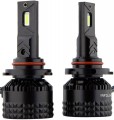Voltage
Operating voltage of the auto lamp.
In different types of equipment, the voltage of on-board networks is also different. Therefore,
car lamps for passenger cars are designed for a voltage of 12 V, and
car lamps for trucks(and other similar equipment, such as buses) are designed for 24 V. However, there are also more specific options:
—
12/24 V. Lamps with the possibility of use in both types of on-board networks - both passenger cars and trucks. This versatility is found mainly among LED models, as well as in some types of xenon (see “Type”): these types of lamps are equipped with control circuits that can automatically adjust to the on-board network voltage.
— 85 V. Value found in models with xenon operating principle (see “Type”). In this case, we mean the voltage supplied to the lamp from the ignition unit (see below); the ignition unit itself is connected to the on-board network and is usually designed for 12 V. Data on the operating voltage of the lamp itself may be needed if you need to select a separate ignition unit for it.
- 40 V. Another option for increased voltage in xenon lamps; the meaning is completely similar to the 85 V described above, but is much less common.
Brightness
Luminous flux produced by a car lamp; for dual-mode models like bi-xenon (see “Type”), the value at maximum brightness is indicated.
This parameter characterizes the actual brightness and efficiency of the lamp; it can be used to directly evaluate and compare different models, regardless of their type and power consumption (but only at the same color temperature - see below for more details). The brightest are headlight lamps (see “Purpose”), in them this indicator can
exceed 4000 lm and vary noticeably from model to model. Therefore, when choosing such a lamp, you should pay special attention to the characteristics of the luminous flux. It should be borne in mind that too bright headlights are just as undesirable as too dim ones: high brightness creates not only the risk of dazzling for oncoming cars, but also discomfort for the driver himself. Optimal luminous flux values can be indicated in the documents for the car or for the headlight itself; if such data is not available, you can turn to other special sources.
As for other types of lamps, in models for auxiliary lighting the luminous flux is up to 800 lm, and in lamps for the instrument panel - up to 55 lm. Moreover, in both cases, the brightness is selected by the manufacturer taking into account the specific specialization and location of the lamp, so in such models this parameter is not a key one.
Colour temperature
The colour temperature of the light emitted by the lamp. The overall colour of the glow depends on this indicator; and note that the higher the colour temperature, the more “cold” the light looks, the closer it is to blue and blue. Traditional incandescent bulbs produce warm light at 2500-3000K, 3000-3500K can be described as "slightly warmer than neutral", neutral white corresponds to temperatures of
3700-4500K, higher values correspond to cooler shades, and temperatures
over 5000K characteristic of lamps with a blue (blue) colour of the glow.
Note that in this case the colour temperature of the lamp itself (more precisely, its filament or LED element) is indicated, and not the actual shade of the glow that it will give out; for the difference between these indicators, see "Glow colour". Also note here that it is possible to evaluate the shade of light by colour temperature in headlight lamps (see "Intended use"), for which the white colour of the glow is claimed. At the same time, this indicator has a very practical meaning: the warm colour of the light is considered optimal in wet weather, the neutral one gives the highest visible brightness, all other things being equal, and the cold “long-range” one can be subjectively pleasant for some drivers, and can also be used as an element of external tuning.

